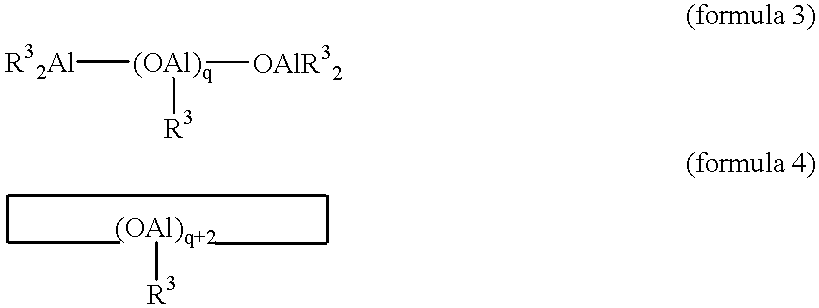Modified olefin (co)polymer composition, process for preparing the same, and modified olefin (co)polymer composition molding
- Summary
- Abstract
- Description
- Claims
- Application Information
AI Technical Summary
Benefits of technology
Problems solved by technology
Method used
Image
Examples
example 1-1
(1) Preparation of a transition metal compound catalyst component
0.3 liter of decane, 48 g of magnesium chloride anhydride, 170 g of orthotitanate-n-butyl and 195 g of 2-ethyl-1-hexanol were mixed in a stainless steel reactor with a stirrer, then heated and dissolved while stirring at 130.degree. C. for one hour so as to have a uniform solution. This uniform solution was heated to 70.degree. C. Then 18 g of di-i-butyl phthalate was added to the solution while stirring. One hour later, 520 g of silicon tetrachloride was added over 2.5 hours so as to form a solid precipitate. Further, the solution was heated at 70.degree. C. and maintained for one hour. The solid was separated from the solution and washed with hexane to obtain a solid product.
The whole amount of the solid product was mixed with 1.5 liters of titanium tetrachloride dissolved in 1.5 liters of 1,2-dichloroethane. Then, 36 g of di-i-butyl phthalate was added thereto and the mixture was reacted at 100.degree. C. for two ho...
example 1-2
Polypropylene composition pellet was obtained by the same method as in Example 1-1, and by using this pellet, a JIS type test piece was produced with an injection molding machine under the conditions of a molten resin temperature at 230.degree. C. and a die temperature at 50.degree. C. The test piece was placed in a polyethylene terephthalate bag with a stopcock. Then, inside the bag was made to be a nitrogen atmosphere by repeating operations of evacuating the inside of the bag and supplying nitrogen gas up to the atmospheric pressure ten times. Then, the bag was fixed to the conveyor for irradiation of electron rays.
For irradiation with electron rays, Cockcroft-Walton accelerator was used and was carried out by passing the bag through a conveyor (conveyor rate: 0.97 m / min) at the point 20 cm below from the irradiation window under the conditions of acceleration voltage of 2 MV and electric current of 1.0 mA, so that the dose absorbed by the propylene polymer composition contained ...
example 1-3
The pellets of modified polypropylene composition that had been obtained by the same manner as in Example 1-1 were used and formed into a sheet having a thickness of 0.4 mm by the use of a T die sheet molding machine having a screw diameter of 65 mm at the resin temperature of 230.degree. C. and cooling temperature of 60.degree. C. The data of heating behavior to show the molding properties of the sheet at this time are shown in Table 1-3.
It was found that the resultant molding properties were quite excellent: more specifically, the hanging amount is small, the returning rate was 100% and maintaining time was very long such as 150 seconds. In particular, the molding property was suitable for thermally molding a large size sheet.
PUM
| Property | Measurement | Unit |
|---|---|---|
| Percent by mass | aaaaa | aaaaa |
| Percent by mass | aaaaa | aaaaa |
| Percent by mass | aaaaa | aaaaa |
Abstract
Description
Claims
Application Information
 Login to View More
Login to View More - R&D
- Intellectual Property
- Life Sciences
- Materials
- Tech Scout
- Unparalleled Data Quality
- Higher Quality Content
- 60% Fewer Hallucinations
Browse by: Latest US Patents, China's latest patents, Technical Efficacy Thesaurus, Application Domain, Technology Topic, Popular Technical Reports.
© 2025 PatSnap. All rights reserved.Legal|Privacy policy|Modern Slavery Act Transparency Statement|Sitemap|About US| Contact US: help@patsnap.com

